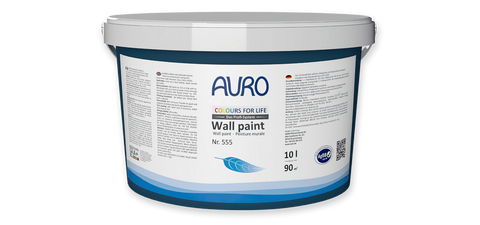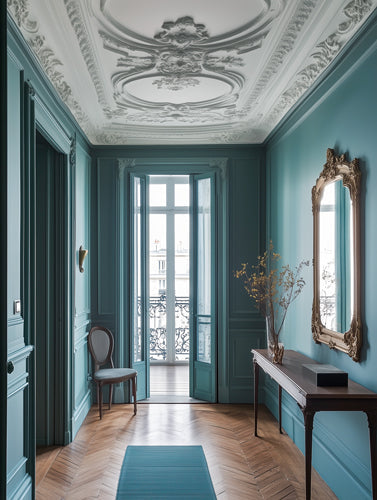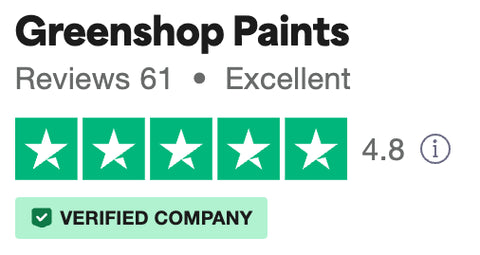Why Natural Breathable Solutions Work on Mould & Moisture
Damp and mould can’t be eliminated without addressing the underlying causes. Simply painting over the problem won’t fix it, but the right paint can be part of an effective solution.
In this guide we’ll look at the best damp proof paint for mould and moisture, and explain why a natural breathable paint solution is superior to traditional barrier based paints which attempt to eliminate moisture through waterproofing.
Natural eco-friendly paint options are highly effective solutions for damp walls because they allow trapped moisture to escape, and can help regulate humidity in problem areas.
Causes of Damp Walls and Why Conventional Paint Can Fail
Damp walls are caused by moisture trapped inside the walls surfaces. Non-breathable building materials can contribute to this issue, particularly in older properties. Inadequate ventilation, condensation, and water ingress from external sources like damaged brickwork or masonry can also contribute.

Cellars, basements, and walls built below ground level are also more prone to damp. Conventional solutions to treat damp focus on creating a non breathable barrier in an attempt to waterproof the room. This can lead to walls being plastered in non breathable gypsum based plasters and plastic based paints. These solutions can work short term, however in the longer term moisture will be trapped underneath the surface causing moisture damage and saturating walls.
That’s why breathable, natural paints are so effective. They allow moisture to escape naturally while offering protection and durability. Using breathable building materials such as breathable lime plaster, limewash, clay paint, and breathable paints will help keep rooms naturally dry long term.
Fix the Cause First – Condensation, Leaks & External Water Ingress
Before you choose paint, you must first identify and take steps to fix the cause of damp and mould in your home.
Look for:-
- Poor ventilation - a major cause of condensation.
- Leaky gutters or downpipes.
- Cracks in exterior walls or roofing issues.
- Plumbing leaks inside walls.
- High ground levels outside that breach the damp proof course.
Fix these issues before you buy damp proof paint. If mould is an issue, make sure all the spores are eradicated and investigate methods to improve airflow like extractor fans, trickle vents, or using dehumidifiers.
What Makes Natural Paint Ideal for Damp Walls?
Clay paint, lime paint, and mineral based silicate paints are all highly breathable. They will allow moisture trapped in walls to escape, which helps reduce the chances of damage to home structures and decor, as well as reducing mould risk.
Key benefits of natural paints for damp walls:
- Highly breathable - supports a natural drying process to remove moisture.
- Free from harmful VOCs and chemicals.
- Contain natural anti-mould ingredients like lime, which have antifungal properties due to high pH levels.
- Long lasting and durable without sealing in moisture. Anti mould properties will not degrade over time like conventional paint.
Top natural brands like Auro, Earthborn, and Graphenstone offer specialist paints designed for damp environments.
How to Treat Damp Walls Before Painting
Treat damp walls properly before decorating for a long term solution. Simply painting over your problems is not a good idea and leads to peeling paint, damaged plaster, and a return of mould infestation.
Follow these steps:-
1. Identify Moisture Sources - fix the root cause of damp. Is it condensation? Poor external brickwork, rising damp? Painting over active damp will just hide the issue temporarily, and will be an expensive waste of time and effort.
2. Let The Wall Dry - don’t paint until all the damp is gone. Use a dehumidifier, heat the space, and don’t rush so you can get the room painted. Natural paints should be applied to a dry surface in order to be most effective.
3. Clean Mould Thoroughly - if you have visible mould on your walls, use a natural but effective product like Auro 412 to kill the spores, and follow it up with a treatment of Auro 413 to retard future mould growth.
4. Prepare The Surface Lightly sand the wall to remove flaky patches and create a sound surface. You don’t need to get back to bare plaster, but aim for an even finish.
6. Choose your paint Now you're ready to apply a breathable paint. Use a natural, mould resistant paint like Auro 327 or Auro 303 - the premium version of 327, or a natural claypaint like Earthborn.
How to Apply Paint Correctly
Even the best natural damp proof paint needs proper prep and application to work well. Your paint is only as good as the surface it’s on, and will last much longer if properly applied.
Make sure the wall is dry and clean as per the instructions above.
Use a primer or mist coat if the surface requires it.
Apply paint in two thin, even coats ensuring all instructions are followed.
Allow sufficient drying time between coats to avoid issues like paint bubbling.
See Also: How to Apply Anti-Fungal Paint
Best Paints for Damp Walls - Natural Product Recommendations
Here’s our top natural paint recommendations to keep damp away:-
Auro 321 - our best value breathable white paint. This is a great budget option for damp prone walls. Particularly suited to low traffic areas such as cellars, or as an option for outbuildings.
Auro 303 or 524 - great paint for damp walls in higher traffic areas such as hallways or lounge rooms. Auro 303 is our “cleanest” paint and is very breathable and MIT free (sd <0.01).
Auro 327 - best paint for damp walls where mould is also an issue.
Best Natural Damp Paint for Bathrooms
Bathrooms are incredibly damp spaces due to constant use for bathing. They’re often poorly ventilated, meaning getting the best paint for damp conditions is vital.
Our top picks for bathrooms are:-
Auro 555 - our top selling high quality natural emulsion. Breathable and wipeable making it ideal for bathroom use.
Auro Eggshell - Satin sheen, available in 96 natural colours. Also suitable for wood.
Earthborn Eggshell - Satin sheen, easy to apply and hard wearing making it ideal for high traffic areas like bathrooms.
Auro 327 - for bathrooms where mould on walls and ceilings is an issue.
Bathrooms are the most common place for condensation and mould to take hold. You need a highly breathable, washable paint that can handle humidity.
See Also: Best mould resistant bathroom paints | Browse our full bathroom paints range
Mould Resistant Paint vs Regular Paint - What’s The Difference?
If you’re dealing with recurring mould, standard paint will not be an effective solution. Even so called mould resistant conventional paints often contain synthetic biocides that degrade over time and become less effective.
Natural anti mould paints like Auro 303 and 327 allow moisture to escape naturally, discouraging mould from taking hold. Because their ingredients are naturally mould resistant, the effectiveness will never degrade.
See Also: Mould Resistant Paint vs Regular Paint – What’s the Difference?
Can You Paint Over Mould?
You can’t just paint over mould. This would be a short term solution at best, and might cause the issue to worsen later. To get rid of mould, you must clean away and kill any existing spores.
Painting over mould will just seal spores between paint layers which can cause damage to your plaster and paint finish. If you don’t enjoy flaky, mouldy walls do not paint over mould!
We recommend using Auro 412 to remove mould naturally and Auro 413 as a prep layer to discourage regrowth.
A Healthier, Breathable Way to Deal with Damp Walls
Dealing with damp does not need to involve the harsh chemicals or plastic ingredients often used in conventional paint products. With proper prep and the right natural products, you can paint your home in a way that supports clean and healthy air, reduces mould, and lets moisture escape naturally.
See Also: Best Natural Anti Mould Paint
See our range of paint colours, and grab a paint colour chart or paint swatch for some style inspiration!
Want personalised advice? Get in touch with the Greenshop Paints team for expert help.





